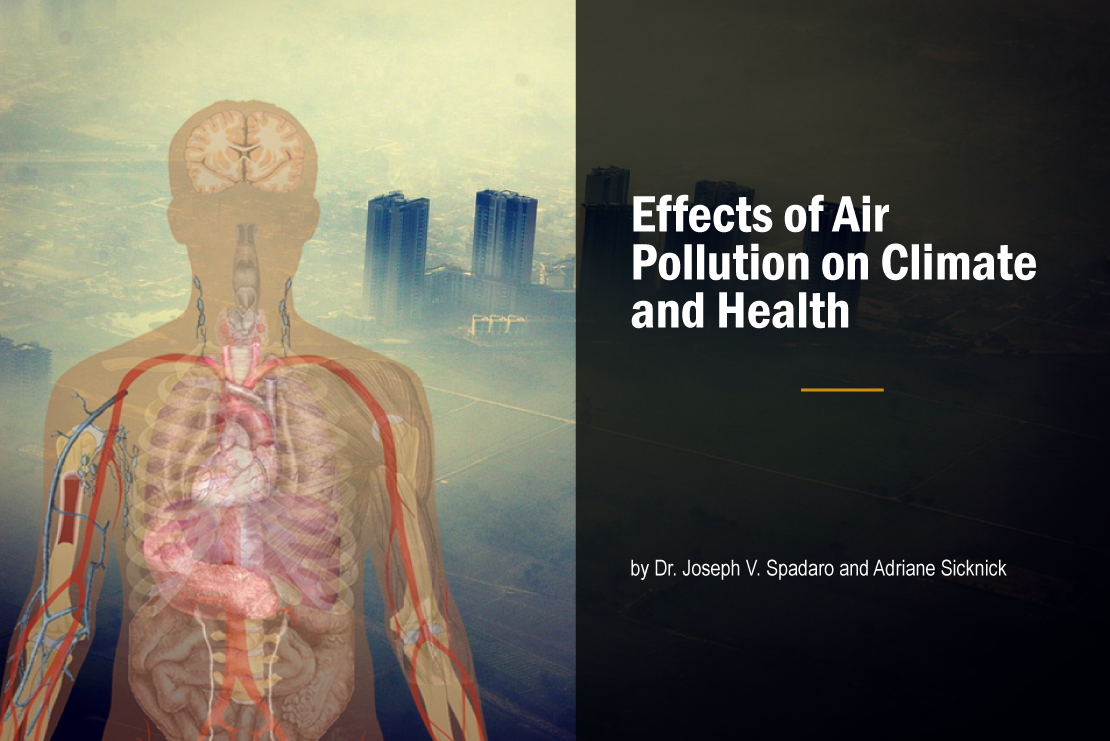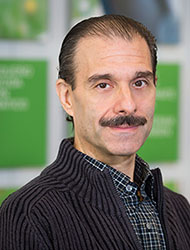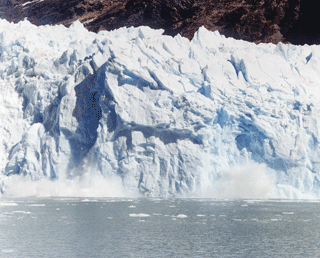Spring/Summer 2019 Issue

Image of a city full of pollution and the anatomy of the human body (credit Pixebay & Wikipedia).

More than 275 scientific studies published over the last decade have shown that greenhouse gases are a danger to public health and welfare. “Some studies suggest that [Earth] can only afford to emit roughly a thousand giga metric tons of CO2 cumulatively between 2000 and 2050 if we are to achieve the ambitious goal set forward in the Paris Agreement in 2015 to limit the global change in temperature to well below 2℃ above pre-industrial levels.” said world-renowned alumnus Joseph V. Spadaro ’81.
As an environmental scientist working for the Basque Center for Climate Change in Spain (and other international organizations, including the World Health Organization in Bonn, Germany), Spadaro’s work focuses on air pollution and its link to climate change. His team has been looking at different policies — air quality and carbon reduction policies — to stabilize the carbon concentrations in the atmosphere, limit health and environmental consequences associated with increasing ambient temperatures and anomalous climate events (such as heatwaves), and assess health and economic benefits of the proposed mitigation interventions.
Despite the rampant increase in CO2 emissions by humans at the turn of the 21st century, the Earth experienced a climate hiatus. The general public began disbelieving the reports on climate change because the air temperature was not increasing.
"Urban health initiatives, such as the World Health Organization, allow individuals
at the local level the opportunity to assist in planning sustainable cities."
“With the improvements in measurements and the increase in data points, scientists have now found that the temperature has increased significantly since 2014. In fact, most of the observed increase in temperature (about 1.5ºF) since pre-industrial times has happened after the mid-1970s,” Spadaro explained.
The Earth experiences natural cyclical events that may be further exacerbated by orbital perturbations, changes in solar output, or disturbances caused by natural events, such as volcanic eruptions, that may cause fluctuation in the weather cycle. Changes in global air circulation patterns, enhanced by the presence of higher CO2 concentrations, lead to atypical weather patterns such as the cold snaps we experienced in the United States last winter. These anomalous events provide real-time evidence of a future world affected by climate change. “When talking about global warming, however, climate scientists are concerned with the long-term temperature trend, not the day-to-day oscillation of temperatures or other weather indicators,” explained Spadaro.
The levels of atmospheric carbon dioxide have risen by 50 percent since pre-industrial levels. Since the 1970s, the Earth has seen a consistent positive slope in the increment of the global surface mean temperature. The current global average temperature has already risen by more than 1.2ºC (2.2ºF) and the Earth is seeing repercussions from this increase. In an effort to significantly reduce the risks and impacts of climate change, the Paris Climate Agreement aims to reduce carbon emissions and limit the average global temperature increase to well below 2ºC (3.6ºF).
“In 2010 we emitted nearly 50 giga metric tons of CO2 and other climate altering greenhouse gases. If we stay on this path over the long-term and do nothing to reduce greenhouse gas emissions, we are looking at 4 to 5ºC (7 to 9ºF) temperature increase by the end of the century. Full implementation of the Paris Agreement would limit the increase to 2.5 to 3ºC (4.5 to 5.5ºF), which is still well above the long-term objectives of the accord, and suggests that in the immediate future further efforts to reduce emissions beyond those already pledged by the world nations is needed to protect our planet and its inhabitants,” Spadaro said about climate change.
Greenland and the Antarctic hold 90 percent of the world's freshwater ice. In Greenland, scientists found cavities on the front edges of outlet glaciers [stream of ice from an ice cap to the sea]. The ocean heat is located from 350 to 400 meters below the surface where the water is at sub-tropical levels. This warm water erodes the base of the cavities and destabilizes the ice front which heightens iceberg calving [breaking of ice chunks from edge of glacier which float away and melt quicker].

GIF Courtesy of Wikipedia
“As the ocean warms up, it can hold less heat, thus, it can no longer act as a sink for the additional heat trapped by the CO2 in the atmosphere. This process enhances ambient air temperature rise, as recent scientific evidence has shown. It is a very dynamic system that takes into consideration the different air, water, soil and the ice caps,” said Spadaro.
Climate change also has a significant impact on our health. Carbon dioxide emissions displace oxygen in the atmosphere which results in breathing issues. Spadaro has been working with epidemiologists from the Global Burden of Disease. They recently published a paper in the Proceedings of the National Academy of Sciences regarding new risk models they developed for linking exposure to air particulate pollution and adverse cardiovascular health effects.
Spadaro recently published several papers summarizing work on the latest heatwaves in Spain, on the health benefits of the Paris Accord, and on a new health risk model to estimate the health burdens of ambient air fine particulate matter. His recent work was showcased at the World Health Organization’s first Global Conference on Air Pollution and Health in Geneva in Nov. 2018.
Joseph V. Spadaro Biography
Joseph V. Spadaro graduated from Stockton with a bachelor's degree in Physics in 1981. He holds a Ph.D. in Environmental Science from the École Nationale Supérieure des Mines de Paris, France. Over the past three decades, he has worked in the United States (Princeton University and Argonne National Labs, Chicago, IL) and in Europe (École des Mines de Paris; International Atomic Energy Agency (IAEA), Austria; and Basque Center for Climate Change, Spain). He was a principal investigator of the ExternE Project series of the European Commission (EC). Throughout his career, he has been an expert consultant on various projects funded by international organizations, including the World Bank, Joint Research Centre JRC of the EC, Climate and Development Knowledge Network, OECD, and others.
Spadaro has carried out basic research on air/water/soil pollutant transport modelling, health risk assessment and uncertainty analysis, cost-benefit analysis, co-benefits of climate change mitigation interventions at the urban scale, and software development of integrated impact assessment models for research use and policy analysis. He developed RiskPoll, an integrated multimedia risk assessment computer tool that implements a set of simplified methodologies for quantifying and valuing impacts on public health from routine exposure to classical pollutants, toxic metals, and organic species. At the IAEA, he was the lead developer of Simpacts, a variant of the RiskPoll software, which is disseminated by the agency to its member states. In addition to his continuing work on health risks of air pollution, his research interests encompass the nexus between prioritization of long-term techno-economic options in support of urban climate adaptation and clean air policies, health welfare, heat vulnerability, and consumer attitudes/consumption patterns on energy use, household purchases, and diets.
Spadaro developed for the CIRCLE project Costs of Inaction and Resource scarcity: Consequences for Long-term Economic growth of the Environment Directorate at OECD air pollution health impact indicators for projections out to 2060. He has contributed to the assessment of environmental and health implications of the European Commission’s Action Plan on Circular economy, and is working on methodological enhancements to the AirQ+ model (health impacts of air quality) for the World Health Organization, European Centre for Environment & Health (WHO–ECEH), working on epidemiological associations of ambient air pollution, a joint effort with the Global Burden of Disease community, lifetable and disability adjusted life year calculations (WHO software DALY Calculator). He has developed methods and software tools to assess health co-benefits of carbon interventions (WHO software iSThAT for transportation, and CaRBonH for health benefits of the Paris Climate Accord). Under WHO’s Urban Health Initiative (transferring knowledge into action), he has carried out impact estimates in Accra, Ghana and Kathmandu, Nepal.
Spadaro has lectured on health and climate change in the master’s program in Energy, Economics & Environment at the Scuola Mattei; ENI Corporate University, Milano, Italy (1997-2005); the European Master’s Program at the University of the Basque Country (Spain); University of Maryland, Dept. of Agricultural & Resources Economics (USA); and MINES Paris-Tech (France). Spadaro is also the co-author of several books and major technical works, including: How Much is Clean Air Worth? Calculating the Benefits of Pollution Control (Cambridge University Press, 2014).



